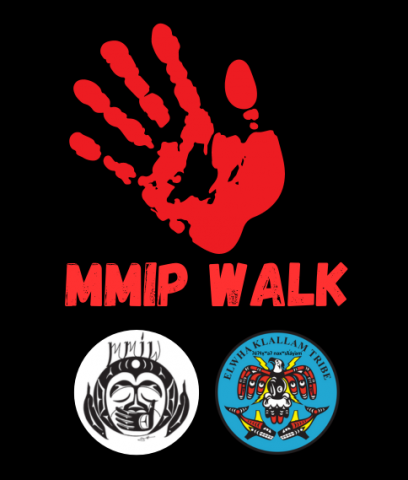Introduced in Montana in 2017 and recognized by the White House in 2019, National Day of Awareness for Missing and Murdered Indigenous Women and Girls is observed every year on May 5. The Day is recognized around the United States and Canada with marches, ceremonies, and the wearing of red. On May 3, 2024, the Lower Elwha Klallam Tribe will host a walk in honor of this important and often overlooked cause.

Friday, May 3 | 2024 | 10am - 2pm
| 10am | Sign making at the Heritage Center* |
| 10:45am | Shawl Ceremony |
| 11am | Solidarity walk to Clallam County Gateway** Presentation and sharing event |
| 12:30pm | Lunch, open sharing, and crafts at the Heritage Center* |
*401 E First St., Port Angeles
**125 E Front St., Port Angeles
Why MMIW
Native American and Alaska Native women and girls are being murdered at an astronomical rate. The Missing and Murdered Indigenous Women (MMIW) movement arose because of the relative inaction on the part of law enforcement in response to this crisis. Originally focused primarily on women and girls, the movement has broadened to include two spirits (trans), men, and boys, becoming known as the Missing and Murdered Indigenous People (MMIP) movement.
Days of Recognition
Both February 14 and May 5 are important days for the MMIW movement. February 14 is MMIW National Day of Action and Awareness, and features Women's Memorial Marches to protest issues like racism, inequality, and violence that Native American people face.
May 5 is Murdered and Missing Indigenous Women Day. It usually includes walks, marches, rallies and more to raise awareness to the issue of MMIW. Participants are encouraged to wear red and the red hand is a prominent design feature.
Statistics
- Indigenous women face murder rates more than 10x the national average.
- Murder is the 3rd leading cause of death for Indigenous women and girls aged 10 to 24.
- More than half of all Indigenous Women experience sexual violence in their lifetime.
- More than half of all Indigenous Women have been physically abused by their partners (55.5%).
- The majority of these murders are committed by non-Native people on Native-owned land.
Sources: https://ww.nativewomenswilderness.org/mmiw
https://www.csvanw.org/mmiw/
Contributing Factors
A variety of factors contribute to the magnitude of violence facing Native American (NA) women and girls. These factors include barriers to gathering accurate data on missing NA women; racial misclassification; underreporting; underutilization of existing resources; and the lack of coordination between tribal, state, local and federal law enforcement agencies.
Sources: https://www.wsp.wa.gov/wp-content/uploads/2019/06/WSP_2951-SHB-Report.p…
https://www.nativewomenswilderness.org/mmiw
"The crisis of missing and murdered Indigenous women is not new. It is more than an epidemic - rather, it is part of the spectrum of violence experienced by Native women for centuries. This crisis of MMIW has deep roots in colonialization and genocide and can be attributed to the lack of legal protections as a result of the systematic erosion of Tribal sovereignty stretching back more than 500 years."
-National Indigenous Women's Resource Center
https://www.niwrc.org/policy-center/mmiw
Why the Silence?
There are numerous reasons for the widespread silence on the MMIW issue.
"[At] the forefront lie issues stemming from the Indian Relocation Act and federal policies. Many Native Americans do not live on the tribals lands or reservations (only 22%) and many frequent a lifestyle of transience between tribal and state lands. This presents a variety of crucial issues involving reporting policies, jurisdictional complications, and communication and coordination problems between agencies.
"Native Americans residing in urban areas have few resources linked to their culture and tribal community. Many Urban Indians, people living in cities, fall into a 'pipeline of vulnerability': people of color, people experiencing poverty, people coming out of the foster care system, people lacking resources or family, people isolated emotionally, physically or psychologically."
Source: https://www.nativehope.org/missing-and-murdered-indigenous-women-mmiw










